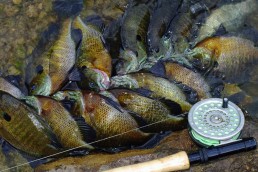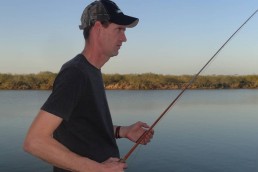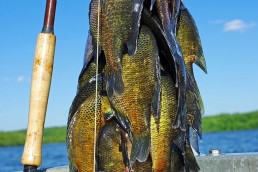Fly Fishing for Big Bluegills: Be Ready to ‘Get Down’
SHARE THIS POST
The abundant panfish loosely lumped under the heading of “bluegills” probably provide more budding fly fishermen with their first feel of a vibrating long rod. Many go on to cast for trout, salmon and saltwater species, but some of us never “grow up,” even after we’re considered experts.
I’m that way, and my old friend, Terry Wilson, is even more dedicated to these little scrappers. He and his wife, Roxanne, co-wrote an excellent book, Bluegill Fly Fishing and Flies. Like me, Terry and Roxanne have fished in many waters for many species, but they never forgot those early thrills and the unique feel of bluegills swimming in rapid circles.
“Beautiful Vibrations” is the title of the Wilson’s first chapter, and I can’t think of a better way to put it. Bluegills indeed, are the perfect fish for a beginning fly caster—they’re eager and they don’t demand accurate deliveries or delicate presentations. Any fly or small popper will get you into the game with as much fishing action as you can find anywhere. You can successfully fly fish for bluegills before you are able to cast very well or even before you really know much about the sport. But like with most types of fishing, you can take it to more advanced levels.
Those of us who have stuck with them through the years and experience have concentrated our efforts toward catching the biggest bluegills, and Illinois gives us plenty of places to try. Bluegills and other panfish inhabit almost every lake, impoundment, river and pond, and sometimes the smallest waters too.
What’s big? Any bluegill bigger than your hand is admirable. Those 10 inches or more are something to brag about. Many big bluegills are caught on worms or crickets, but a fly rod is the most effective.
You can get sound advice on all aspects of fly fishing for bluegills from Terry and Roxanne’s book, but the best advice I can give you for catching more and bigger panfish, is to “get down.”
Are you enjoying this post?
You can be among the first to get the latest info on where to go, what to use and how to use it!
During the spawn is when most anglers chase them, but this clan can be found in the shallows all summer. All manner of weighted nymphs and wet flies will work, and you can use any color you want, but black is best.
My favorite bluegill fly is a weighted black fur ant tied on number 12 or 14 wet fly hooks. Wilson designed his own line of Bully’s Bluegill Flies, which is another weighted sinker that works well. Most any fly rod outfit works for bluegills, but a matched 5- or 6-weight outfit is ideal. You don’t have to spend a fortune either; good, inexpensive graphite fly rods and single-action reels are common.
I would, however, suggest you invest in a good, double-taper fly line and quality leaders. A tippet at 4-pound-test is about right. You can go lighter if you know what you’re doing. You especially want a good floating fly line and a little fly line dressing to keep it buoyant—this is your strike indicator when fishing sinking flies. (Various “strike indicators” attach to the end of a fly line, but make casting more difficult.) High-visibility fly lines help, but watching the fly line to detect strikes is not as difficult as you might think. Most of the time, bluegills and redears both snatch a fly and take off with it, moving the line quickly. This is because they are naturally aggressive and travel in large schools, so they compete with each other for available food. The leader should be between 6 and 9 feet long, depending upon how deep you expect the redears to hang out. As a general rule, use a leader at a length that is twice the measurement of the depth at which you plan to fish. After casting, allow the fly some time to sink. I use a countdown method based upon how fast the fly sinks and how deep I want it to get before imparting any retrieve. As it sinks, pay close attention to the end of the fly line; they often snatch it on the fall.
Once the fly reaches your intended depth, retrieve the line slowly and steadily with a hand-twist retrieve. If you don’t know how to do that, use short, 6-inch strips of the line. The key is to retrieve it slowly. Fly fishing is so effective for panfish not because of the way the line is delivered or because of any “match-the-hatch” aspect, but because of its unique presentation qualities during the retrieve. Once you impart a retrieve, weighted flies quit sinking, even on the slowest retrieve, and the slower you go the more time it spends in the strike zone.
One final piece of advice: Don’t spend too much time in one place. The unavoidable commotion of catching a few from one spot alerts the others that something is wrong. Some get the message as soon as they see their brothers acting crazy and then vanish mysteriously. All fish, including bluegills, secrete an alarm scent when hooked. And when a few of them put this stress odor into the shallows, the whole group gets the message. Some scatter, but all of them become nervous and cautious. And, it can ruin their spawning mood in that season too. If you sit there and wait long enough—as bobber fishermen do—the bluegills will settle down and start biting again. This can take 30 minutes up to a couple of hours. Most fly fishermen are usually more likely to move to another area to find more willing quarry.
Fly fishing for bluegills is the perfect sport for beginners and experts alike. Those “beautiful vibrations” never fade—they just get bigger. And, remember to “get down” for more and larger bluegills. MWO
MWO
SHARE THIS POST
Did you enjoy this post?
You can be among the first to get the latest info on where to go, what to use and how to use it!
Ron Kruger
Ron Kruger has been communicating the outdoor experience for more than four decades. He has worked as a full-time guide for trout on the North Fork, for crappies and bass on Kentucky Lake and for smallmouths on the Current River. He has served as editor of three outdoor magazines, and owns a patent on a fly/lure called the Desperate Diver.




